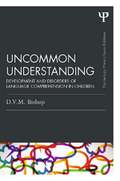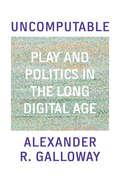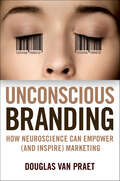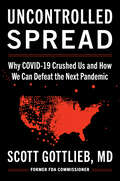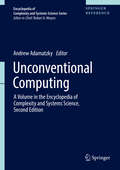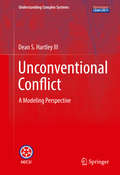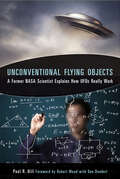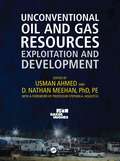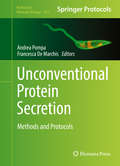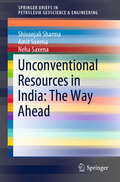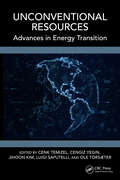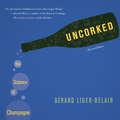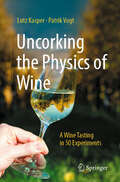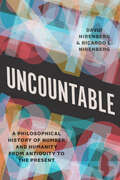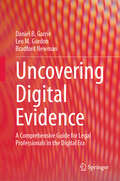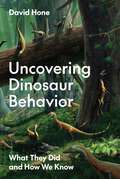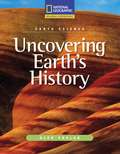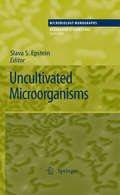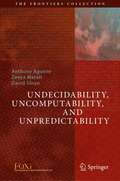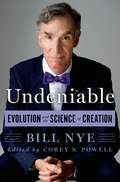- Table View
- List View
Uncommon Understanding: Development and disorders of language comprehension in children (Psychology Press & Routledge Classic Editions)
by Dorothy V. BishopThis is a Classic Edition of Dorothy Bishop's award-winning textbook on the development of language comprehension, which has been in print since 1997, and now includes a new introduction from the author. The book won the British Psychological Society book award in 1999, and is now widely seen as a classic in the field of developmental language disorders. Uncommon Understanding provides a comprehensive account of the process of comprehension, from the reception of an acoustic signal, to the interpretation of communicative intentions, and integrates a vast field of research on language acquisition, psycholinguistics and neuropsychology. In the new introduction Dorothy Bishop reflects on the organization of the book, and developments in the field since the book was first published. A major theme in the book is that comprehension should not be viewed as a unitary skill – to understand spoken language one needs the ability to classify incoming speech sounds, to relate them to a "mental lexicon," to interpret the propositions encoded by word order and grammatical inflections, and to use information from the environmental and social context to grasp an intended meaning. Another important theme is that although neuropsychological and experimental research on adult comprehension provides useful concepts and methods for assessing comprehension, it should be applied with caution, because a sequential, bottom-up information processing model of comprehension is ill-suited to the developmental context. Although the main focus of the book is on research and theory, rather than practical matters of assessment and intervention, the theoretical framework presented in the book will continue to help clinicians develop a clearer understanding of what comprehension involves, and how different types of difficulty may be pin-pointed.
Uncomputable: Play and Politics In the Long Digital Age
by Alexander GallowayA journey through the uncomputable remains of computer historyNarrating some lesser known episodes from the deep history of digital machines, Alexander R. Galloway explains the technology that drives the world today, and the fascinating people who brought these machines to life. With an eye to both the computable and the uncomputable, Galloway shows how computation emerges or fails to emerge, how the digital thrives but also atrophies, how networks interconnect while also fray and fall apart. By re-building obsolete technology using today's software, the past comes to light in new ways, from intricate algebraic patterns woven on a hand loom, to striking artificial-life simulations, to war games and back boxes. A description of the past, this book is also an assessment of all that remains uncomputable as we continue to live in the aftermath of the long digital age.
Unconscious Branding: How Neuroscience Can Empower (and Inspire) Marketing
by Douglas Van PraetFor too long marketers have been asking the wrong question. If consumers make decisions unconsciously, why do we persist in asking them directly through traditional marketing research why they do what they do? They simply can't tell us because they don't really know. Before marketers develop strategies, they need to recognize that consumers have strategies too . . .human strategies, not consumer strategies. We need to go beyond asking why, and begin to ask how,behavior change occurs. Here, author DouglasVan Praet takes the most brilliant and revolutionary concepts from cognitive science and applies them to how we market, advertise, and consume in the modern digital age. Van Praet simplifies the most complex object in the known universe - the human brain - into seven codified actionable steps to behavior change. These steps are illustrated using real world examples from advertising, marketing, media and business to consciously unravel what brilliant marketers and ad practitioners have long done intuitively, deconstructing the real story behind some of the greatest marketing and business successes in recent history, such as Nike's "Just Do It" campaign; "Got Milk?"; Wendy's "Where's the Beef?" ;and the infamous Volkswagen "Punch Buggy" launch as well as their beloved "The Force" (Mini Darth Vader) Super Bowl commercial.
Uncontrolled Spread: Why COVID-19 Crushed Us and How We Can Defeat the Next Pandemic
by Scott GottliebNEW YORK TIMES BESTSELLER“Uncontrolled Spread is everything you’d hope: a smart and insightful account of what happened and, currently, the best guide to what needs to be done to avoid a future pandemic." —Wall Street Journal“Informative and well paced.”—The Guardian“An intense ride through the pandemic with chilling details of what really happened. It is also sprinkled with notes of true wisdom that may help all of us better prepare for the future.”—Sanjay Gupta, MD, chief medical correspondent, CNNPhysician and former FDA commissioner Scott Gottlieb asks: Has America’s COVID-19 catastrophe taught us anything?In Uncontrolled Spread, he shows how the coronavirus and its variants were able to trounce America’s pandemic preparations, and he outlines the steps that must be taken to protect against the next outbreak. As the pandemic unfolded, Gottlieb was in regular contact with all the key players in Congress, the Trump administration, and the drug and diagnostic industries. He provides an inside account of how level after level of American government crumbled as the COVID-19 crisis advanced.A system-wide failure across government institutions left the nation blind to the threat, and unable to mount an effective response. We’d prepared for the wrong virus. We failed to identify the contagion early enough and became overly reliant on costly and sometimes divisive tactics that couldn’t fully slow the spread. We never considered asymptomatic transmission and we assumed people would follow public health guidance. Key bureaucracies like the CDC were hidebound and outmatched. Weak political leadership aggravated these woes. We didn’t view a public health disaster as a threat to our national security.Many of the woes sprung from the CDC, which has very little real-time reporting capability to inform us of Covid’s twists and turns or assess our defenses. The agency lacked an operational capacity and mindset to mobilize the kind of national response that was needed. To guard against future pandemic risks, we must remake the CDC and properly equip it to better confront crises. We must also get our intelligence services more engaged in the global public health mission, to gather information and uncover emerging risks before they hit our shores so we can head them off. For this role, our clandestine agencies have tools and capabilities that the CDC lacks.Uncontrolled Spread argues we must fix our systems and prepare for a deadlier coronavirus variant, a flu pandemic, or whatever else nature -- or those wishing us harm -- may threaten us with. Gottlieb outlines policies and investments that are essential to prepare the United States and the world for future threats.
Unconventional Computing: A Volume in the Encyclopedia of Complexity and Systems Science, Second Edition (Encyclopedia of Complexity and Systems Science Series #22)
by Andrew AdamatzkyThis volume of the Encyclopedia of Complexity and Systems Science, Second Edition, is a unique collection of concise overviews of state-of-art, theoretical and experimental findings, prepared by the world leaders in unconventional computing. Topics covered include bacterial computing, artificial chemistry, amorphous computing, computing with Solitons, evolution in materio, immune computing, mechanical computing, molecular automata, membrane computing, bio-inspired metaheuristics, reversible computing, sound and music computing, enzyme-based computing, structural machines, reservoir computing, infinity computing, biomolecular data structures, slime mold computing, nanocomputers, analog computers, DNA computing, novel hardware, thermodynamics of computation, and quantum and optical computing. Topics added to the second edition include: social algorithms, unconventional computational problems, enzyme-based computing, inductive Turing machines, reservoir computing, Grossone Infinity computing, slime mould computing, biomolecular data structures, parallelization of bio-inspired unconventional computing, and photonic computing.Unconventional computing is a cross-breed of computer science, physics, mathematics, chemistry, electronic engineering, biology, materials science and nanotechnology. The aims are to uncover and exploit principles and mechanisms of information processing in, and functional properties of, physical, chemical and living systems, with the goal to develop efficient algorithms, design optimal architectures and manufacture working prototypes of future and emergent computing devices.
Unconventional Conflict: A Modeling Perspective (Understanding Complex Systems)
by Dean S. Hartley IIIThis book describes issues in modeling unconventional conflict and suggests a new way to do the modeling. It presents an ontology that describes the unconventional conflict domain, which allows for greater ease in modeling unconventional conflict. Supporting holistic modeling, which means that we can see the entire picture of what needs to be modeled, the ontology allows us to make informed decisions about what to model and what to omit. The unconventional conflict ontology also separates the things we understand best from the things we understand least. This separation means that we can perform verification, validation and accreditation (VV&A) more efficiently and can describe the competence of the model more accurately.However, before this message can be presented in its entirety the supporting body of knowledge has to be explored. For this reason, the book offers chapters that focus on the description of unconventional conflict and the analyses that have been performed, modeling, with a concentration on past efforts at modeling unconventional conflict, the precursors to the ontology, and VV&A. Unconventional conflict is a complex, messy thing. It normally involves multiple actors, with their own conflicting agendas and differing concepts of legitimate actions. This book will present a useful introduction for researchers and professionals within the field.
Unconventional Flying Objects: A Former NASA Scientist Explains How UFOs Really Work
by Paul R. HillA NASA R&D engineer does “a masterful job ferreting out the basic science and technology behind the elusive UFO characteristics.” —Edgar Mitchell, Sc.D., Apollo 14 AstronautPaul Hill was a well-respected NASA scientist when, in the early 1950s, he had a UFO sighting. Soon after, he built the first flying platform and was able to duplicate the UFO’s tilt-to-control maneuvers. Official policy, however, prevented him from proclaiming his findings. “I was destined,” says Hill, “to remain as unidentified as the flying objects.”For the next twenty-five years, Hill acted as an unofficial clearing house at NASA, collecting and analyzing sightings’ reports for physical properties, propulsion possibilities, dynamics and more. To refute claims that UFOs defy the laws of physics, he had to make “technological sense . . . of the unconventional object.”After his retirement from NASA, Hill finally completed his remarkable analysis. In Unconventional Flying Objects, published posthumously, he presents his findings that UFOs “obey, not defy, the laws of physics.” Vindicating his own sighting and thousands of others, he proves that UFO technology is not only explainable, but attainable.
Unconventional Hydrocarbon Reservoirs: Coal and Shale (Petroleum Engineering)
by Bodhisatwa Hazra Debanjan Chandra Vikram VishalThis informative book offers a comprehensive exploration of critical reservoir parameters, including quantification techniques and interpretations for evaluating these reservoirs. Readers will also gain insight into the fundamental principles of simulating gas production from coal and shale reservoirs, as well as the key input parameters for building the best-fit reservoir model. Additionally, the book explores various aspects of storing captured CO2 in these reservoirs and their potential role in preventing global temperature increases beyond pre-industrial levels.Energy from conventional petroleum reservoirs and coal has been the backbone of global energy needs for a long time. However, depletion of these fossil fuel reserves, as well as their contribution to rising greenhouse emissions, has prompted a shift to renewable energy sources. Natural gas found in unconventional coal and shale reservoirs is increasingly seen as a greener energy option, emitting approximately 45% less CO2 than conventional sources. Furthermore, due to their vast availability and capacity to sequester atmospheric CO2, unconventional coal and shale reservoirs can facilitate the transition to renewable energy resources.With a focus on achieving temperature stabilization at 1.5°C, this book offers a valuable resource for those interested in renewable energy and mitigating climate change.
Unconventional Hydrocarbon Resources: Techniques for Reservoir Engineering Analysis (AGU Advanced Textbooks #1)
by Reza Barati Mustafa M. AlhubailA comprehensive textbook presenting techniques for the analysis and characterization of shale plays Significant reserves of hydrocarbons cannot be extracted using conventional methods. Improvements in techniques such as horizontal drilling and hydraulic fracturing have increased access to unconventional hydrocarbon resources, ushering in the “shale boom” and disrupting the energy sector. Unconventional Hydrocarbon Resources: Techniques for Reservoir Engineering Analysis covers the geochemistry, petrophysics, geomechanics, and economics of unconventional shale oil plays. The text uses a step-by-step approach to demonstrate industry-standard workflows for calculating resource volume and optimizing the extraction process. Volume highlights include: Methods for rock and fluid characterization of unconventional shale plays A workflow for analyzing wells with stimulated reservoir volume regions An unconventional approach to understanding of fluid flow through porous media A comprehensive summary of discoveries of massive shale resources worldwide Data from Eagle Ford, Woodford, Wolfcamp, and The Bakken shale plays Examples, homework assignments, projects, and access to supplementary online resources Hands-on teaching materials for use in petroleum engineering software applications The American Geophysical Union promotes discovery in Earth and space science for the benefit of humanity. Its publications disseminate scientific knowledge and provide resources for researchers, students, and professionals.
Unconventional Oil and Gas Resources: Exploitation and Development (Emerging Trends and Technologies in Petroleum Engineering)
by Usman Ahmed D. Nathan MeehanAs the shale revolution continues in North America, unconventional resource markets are emerging on every continent. In the next eight to ten years, more than 100,000 wells and one- to two-million hydraulic fracturing stages could be executed, resulting in close to one trillion dollars in industry spending. This growth has prompted professionals ex
Unconventional Protein Secretion
by Andrea Pompa Francesca De MarchisThis volume presents relevantbackground information to understanding the molecular basis governingunconventional protein secretion (UPS), and in particular explores the latesttechniques and protocols that have been successfully applied for the study ofthis topic. Detailed chapters include an overview of conventional andunconventional secretory pathways along with multidisciplinary approaches andmethods used for UPS analysis in different organisms. Written in the highly successful Methods inMolecular Biology series format, chapters include introductions to theirrespective topics, lists of the necessary materials and reagents, step-by-step,readily reproducible laboratory protocols, and tips on troubleshooting andavoiding known pitfalls. Authoritative and cutting-edge, UnconventionalProtein Secretion: Methods and Protocols will be usefulfor all interested in the secretory pathway field as well as applications incell biology, cell development, biomedical research, and healthcare.
Unconventional Reservoirs: A Reservoir Engineering Approach (SpringerBriefs in Petroleum Geoscience & Engineering)
by Mehdi Ostadhassan Amin Taghavinejad Reza DaneshfarThis book provides a succinct overview on the application of rate and pressure transient analysis in unconventional petroleum reservoirs. It begins by introducing unconventional reservoirs, including production challenges, and continues to explore the potential benefits of rate and pressure analysis methods. Rate transient analysis (RTA) and pressure transient analysis (PTA) are techniques for evaluating petroleum reservoir properties such as permeability, original hydrocarbon in-place, and hydrocarbon recovery using dynamic data. The brief introduces, describes and classifies both techniques, focusing on the application to shale and tight reservoirs. Authors have used illustrations, schematic views, and mathematical formulations and code programs to clearly explain application of RTA and PTA in complex petroleum systems. This brief is of an interest to academics, reservoir engineers and graduate students.
Unconventional Resources in India: The Way Ahead (SpringerBriefs in Petroleum Geoscience & Engineering)
by Shivanjali Sharma Amit Saxena Neha SaxenaThis book addresses unconventional hydrocarbon resources in India and the prospects for their exploitation. Each chapter focuses on a particular unconventional resource, including gas hydrates, coal bed methane and shale, while the book as a whole takes into account the government’s projections concerning these resources. The book provides readers with essential information on the nation’s energy requirements, methods of exploiting its available unconventional resources, and their contribution to meeting India’s energy requirements. It also addresses the various geological conditions that are necessary for the exploration of these resources, and enables readers to understand the challenges that need to be overcome. Its logical, clearly structured chapters make the book an ideal starting point for readers interested in unconventional energy resources. It will especially benefit undergraduate and graduate students in the field of Energy Engineering, as well as academic researchers and industry professionals seeking an overview of the status quo of unconventional hydrocarbon resources in India.
Unconventional Resources: Advances in Energy Transition
by Jihoon Kim Luigi Saputelli Cenk Temizel Ole Torsæter Cengiz YeginThe oil and gas sector is a vital player in the energy transition. With their vast resource potential, unconventional shale plays will be an essential part in enabling this change. Unconventional Resources serves as a comprehensive reference covering the latest technologies, methodologies, and applications of unconventional shale resources in the oil and gas industry, and their role in the evolution of the sector's energy transition.This book: Offers an overview of geophysics, geology, and reservoir characterization in unconventional resources Discusses drilling, well stimulation and completion, production engineering, and artificial lift Covers reservoir management and surveillance, recovery enhancement, production forecasting, and surface facilities and testing Details technical and technological advances, including machine learning, AI, data analytics, and Industry 4.0 Explores the latest methods/workflows in performance analysis in unconventional plays Employs integrated and hybrid approaches to the energy transition The book provides surface and subsurface technical professionals in the oil and gas industry a thorough overview of unconventionals along with the integrated/hybrid applications that will enable them to stay current with the industry's transition.
Unconventional Water Resources
by Vladimir Smakhtin Manzoor Qadir Sasha Koo-Oshima Edeltraud GuentherThe world is faced with a growing number of complex and interconnected challenges. Water is among the top 5 global risks in terms of impacts, which would be far reaching beyond socio-economic challenges, impacting livelihoods and wellbeing of the people.As freshwater resources and population densities are unevenly distributed across the world, some regions and countries are already water scarce. Water scarcity is expected to intensify in regions like the Middle East and North Africa (MENA), which has 6% of the global population, but only 1% of the world’s freshwater resources. Climate change adds to this complexity as it is leading to rainfall uncertainty and extended droughts periods, mostly in arid areas.Increasing water scarcity is now recognized as a major cause of conflict, social unrest and migration and at the same time water is increasingly considered as an instrument for international cooperation to achieve sustainable development. Tapping and assessing sustainably every available option in water-scarce areas is needed as pressure continues to build on limited water resources.The stark fact is that conventional water provisioning approaches relying on snowfall, rainfall and river runoff are not enough to meet growing freshwater demand in water-scarce areas. Water-scarce countries need a radical re-think of water resource planning and management that includes the creative exploitation of a growing set of viable but unconventional water resources for food production, livelihoods, ecosystems, climate change adaption, and sustainable development. Unconventional water resources are generated as a by-product of specialized processes; need suitable pre-use treatment; require pertinent on-farm management when used for irrigation; or result from a special technology to collect/access water.
Uncorked: Negotiating Science and Belief in the Natural Wine Movement
by Pablo Alonso González Eva Parga DansNatural wine is a captivating and rapidly evolving phenomenon in the world of viticulture and winemaking. This movement, characterized by minimal intervention, low or no chemical additives, and a focus on terroir-driven expressions of grapes, has ignited a passionate following among wine enthusiasts, sommeliers, and eco-conscious consumers. It's more than just a beverage; it embodies a philosophy that aligns with contemporary sustainability and wellness trends. Though natural wine enthusiasts have produced ample coverage of the natural wine movement in books, essays and films, academics have lagged behind in their examination of this global phenomenon. In Uncorked: Negotiating Science and Belief in the Natural Wine Movement, scholarly discussion reaches across disciplines to offer valuable insights for researchers, producers, wine enthusiasts and anyone with an interest in this movement. Exploring the relevance of natural wine offers a unique lens through which to examine the intersection of tradition, innovation, environmental stewardship, and the evolving tastes of modern consumers. Through the stories of the winemakers, the science behind natural fermentation, and the cultural and historical context, this book aims to provide a comprehensive look at how this movement is shaping the future of wine and our relationship with the natural world. Each essay from a thought leader in their respective field delves deep into the historical, ecological, and sociocultural dimensions of natural winemaking, shedding light on its ancient roots, ecological practices, and the philosophical underpinnings that drive the movement. Discussions of regulatory and consumer aspects will also elucidate the practical considerations of making and selling natural wine. Uncorked: Negotiating Science and Belief in the Natural Wine Movement is a groundbreaking edited book that offers a comprehensive and scholarly exploration ofthe world of natural wine. This interdisciplinary volume brings together leading experts in fields ranging from enology and sensory studies to anthropology and philosophy, creating a rich tapestry of insights into the production, consumption, and cultural significance of natural wine. Academics, winemakers and wine enthusiasts alike will be illuminated by this volume.
Uncorked: The Science of Champagne - Revised Edition
by Gérard Liger-BelairThe spectacular science behind champagne's effervescenceUncorked quenches our curiosity about the inner workings of one of the world's most prized beverages. Esteemed for its freshness, vitality, and sensuality, champagne is a wine of great complexity. Mysteries aplenty gush forth with the popping of that cork. Just what is that fizz? Can you judge champagne quality by how big the bubbles are, how long they last, or how they behave before they fade? And why does serving champagne in a long-stemmed flute prolong its chill and effervescence? Through lively prose and a wealth of state-of-the-art photos, this revised edition of Uncorked unlocks the door to what champagne is all about.Providing an unprecedented close-up view of the beauty in the bubbles, Gérard Liger-Belair presents images that look surprisingly like lovely flowers, geometric patterns, even galaxies as the bubbles rise through the glass and burst forth on the surface. He illustrates how bubbles form not on the glass itself but are "born" out of debris stuck on the glass wall, how they rise, and how they pop. Offering a colorful history of champagne, Liger-Belair tells us how it is made and he asks if global warming could spell champagne's demise. In a brand-new afterword, he updates the reader on new developments in the world of bubble science and delves even more deeply into the processes that give champagne its unique and beautiful character.Bubbly may tickle the nose, but Uncorked tackles what the nose and the naked eye cannot—the spectacular science that gives champagne its charm and champagne drinkers immeasurable pleasure.
Uncorking the Physics of Wine: A Wine Tasting in 50 Experiments
by Patrik Vogt Lutz KasperA still sealed wine bottle, a corkscrew, and a smartphone are undoubtedly a promising combination. Notify good friends with one device and extract the cork from the bottle with the other – what more could one want? Perhaps, in addition to quenching the thirst, the "mind" also craves satisfaction!With this book, you practice your physics mindfulness during the enjoyment of wine: you learn how to determine the speed of sound with the characteristic pop sound when opening the bottle, how to properly decant wine, what peculiarities red wine shows in laser light, and what Pythagoras has to do with wine.Uncorking the Physics of Wine creates the wonderful connection between science and wine. An inspiring non-fiction book – with experiments to participate in and replicate, or simply to savor. The authorsLutz Kasper studied physics and mathematics at University of Hannover to become a teacher and completed his doctorate in physics education at the University of Potsdam. He has been a professor of physics and physics education at University of Education Schwäbisch Gmünd since 2011. In recent years, he also has worked as an invited visiting professor in the physics department of Grand Valley State University (MI) and at the Taraz Pedagogical University (Kazakhstan).Patrik Vogt studied physics and mathematics on a teaching degree at the University of Koblenz-Landau and was a research assistant and secondary school teacher at various schools and universities in Germany until 2019. Since then, he is head of the department "Media Education, Mathematics, Natural Sciences, Music, Philosophy" at the ILF in Mainz, Germany. His work focuses on the possible uses of mobile devices in physics lessons, especially as a measuring instrument, task culture and the physics of everyday life.
Uncountable: A Philosophical History of Number and Humanity from Antiquity to the Present
by David Nirenberg Ricardo L. NirenbergRanging from math to literature to philosophy, Uncountable explains how numbers triumphed as the basis of knowledge—and compromise our sense of humanity. Our knowledge of mathematics has structured much of what we think we know about ourselves as individuals and communities, shaping our psychologies, sociologies, and economies. In pursuit of a more predictable and more controllable cosmos, we have extended mathematical insights and methods to more and more aspects of the world. Today those powers are greater than ever, as computation is applied to virtually every aspect of human activity. Yet, in the process, are we losing sight of the human? When we apply mathematics so broadly, what do we gain and what do we lose, and at what risk to humanity? These are the questions that David and Ricardo L. Nirenberg ask in Uncountable, a provocative account of how numerical relations became the cornerstone of human claims to knowledge, truth, and certainty. There is a limit to these number-based claims, they argue, which they set out to explore. The Nirenbergs, father and son, bring together their backgrounds in math, history, literature, religion, and philosophy, interweaving scientific experiments with readings of poems, setting crises in mathematics alongside world wars, and putting medieval Muslim and Buddhist philosophers in conversation with Einstein, Schrödinger, and other giants of modern physics. The result is a powerful lesson in what counts as knowledge and its deepest implications for how we live our lives.
Uncovering Digital Evidence: A Comprehensive Guide for Legal Professionals in the Digital Era
by Daniel B. Garrie Leo M. Gordon Bradford NewmanThis book serves as a comprehensive guide for legal practitioners, providing a primer on digital forensic evidence and essential technological concepts. Through real-world examples, this book offers a systematic overview of methodologies and best practices in collecting, preserving, and analyzing digital evidence. Grounded in legal precedent, the following chapters explain how digital evidence fits within existing legal frameworks, addressing questions of admissibility, authenticity, and ethical considerations. The aim of this book is to bridge the digital knowledge gap that often hinders the legal process, empowering readers with the tools needed for effective engagement in tech-related legal matters. Ultimately, the book equips judges, lawyers, investigators, and jurists with the knowledge and skills to navigate the digital dimensions of legal cases proficiently.
Uncovering Dinosaur Behavior: What They Did and How We Know
by David HoneHow scientists are unravelling one of the most tantalizing questions in paleontologyOur understanding of dinosaur behavior has long been hampered by the inevitable lack of evidence from animals that went extinct more than sixty-five million years ago and whose daily behaviors are rarely reflected by the fossil record. Today, with the discovery of new specimens and the development of new and cutting-edge techniques, paleontologists are making major advances in reconstructing how dinosaurs lived and acted. Uncovering Dinosaur Behavior provides an unparalleled look at this emerging field of science, presenting the latest findings on dinosaur behavior and explaining how researchers interpret the often minimal and even conflicting information available to them.David Hone begins by introducing readers to the fundamentals of dinosaur biology, diversity, and evolution, and goes on to describe behaviors across the whole range of species and groups, from feeding and communication to reproduction, sociality, and combat. Speculation about dinosaur behavior goes back to the earliest scientific studies of these &“terrible lizards.&” Hone traces how pioneering science is opening a window into prehistoric life as never before, and discusses future directions of research in this thrilling and rapidly growing area of paleontology.Written by one of the world&’s leading dinosaur experts and featuring accurate color recreations by paleoartist Gabriel Ugueto along with a wealth of photos and diagrams, Uncovering Dinosaur Behavior is a foundational work on the subject and an invaluable reference for anyone interested in these amazing creatures.
Uncovering Earth's History
by Glen PhelanFollow the discovery of a perfectly preserved woolly mammoth, an Ice Age animal found by a family in Siberia. Learn how fossils tell us about climate, events, and life on Earth thousands of years ago.
Uncultivated Microorganisms
by Slava S. EpsteinThe number of existing microbial species may be in the millions, but only a few thousand have been isolated in pure culture and described. The principal reason for this tremendous disparity is that, mysteriously, over 99% of all environmental microorganisms refuse to grow in the laboratory. The phenomenon of microbial uncultivability has been recognized as one of the main challenges for basic and applied microbiology, and finding a way to access this uncultivated microbial majority may change many aspects of biology and biotechnology as we know them today. This volume describes the discovery of the phenomenon, the current hypotheses on its physiological and molecular nature, state-of-the-art approaches to "outsmarting" the uncultivated microorganisms, and the importance of the uncultivated microbial majority in medicine and biotechnology. It reveals the hidden universe of uncultivated microorganisms, their unparalleled diversity and enormous potential for application.
Undecidability, Uncomputability, and Unpredictability (The Frontiers Collection)
by Anthony Aguirre Zeeya Merali David SloanFor a brief time in history, it was possible to imagine that a sufficiently advanced intellect could, given sufficient time and resources, in principle understand how to mathematically prove everything that was true. They could discern what math corresponds to physical laws, and use those laws to predict anything that happens before it happens. That time has passed. Gödel’s undecidability results (the incompleteness theorems), Turing’s proof of non-computable values, the formulation of quantum theory, chaos, and other developments over the past century have shown that there are rigorous arguments limiting what we can prove, compute, and predict. While some connections between these results have come to light, many remain obscure, and the implications are unclear. Are there, for example, real consequences for physics — including quantum mechanics — of undecidability and non-computability? Are there implications for our understanding of the relations between agency, intelligence, mind, and the physical world? This book, based on the winning essays from the annual FQXi competition, contains ten explorations of Undecidability, Uncomputability, and Unpredictability. The contributions abound with connections, implications, and speculations while undertaking rigorous but bold and open-minded investigation of the meaning of these constraints for the physical world, and for us as humans.
Undeniable: Evolution And The Science Of Creation
by Bill Nye Corey S. Powell"Evolution is one of the most powerful and important ideas ever developed in the history of science. Every question it raises leads to new answers, new discoveries, and new smarter questions. The science of evolution is as expansive as nature itself. It is also the most meaningful creation story that humans have ever found. "--Bill Nye <P> Sparked by a controversial debate in February 2014, Bill Nye has set off on an energetic campaign to spread awareness of evolution and the powerful way it shapes our lives. In Undeniable: Evolution and the Science of Creation, he explains why race does not really exist; evaluates the true promise and peril of genetically modified food; reveals how new species are born, in a dog kennel and in a London subway; takes a stroll through 4. 5 billion years of time; and explores the new search for alien life, including aliens right here on Earth. With infectious enthusiasm, Bill Nye shows that evolution is much more than a rebuttal to creationism; it is an essential way to understand how nature works--and to change the world. It might also help you get a date on a Saturday night.
